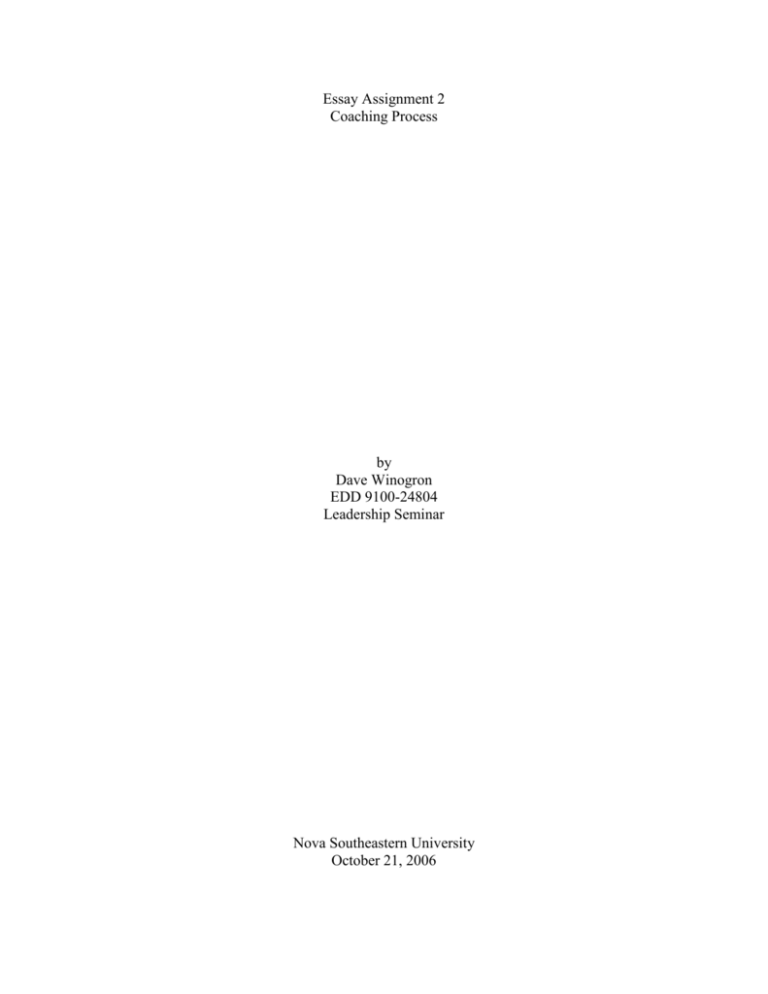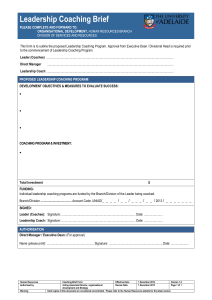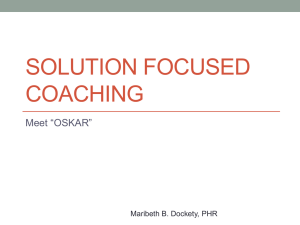Essay Assignment 2 - Nova Southeastern University
advertisement

Essay Assignment 2 Coaching Process by Dave Winogron EDD 9100-24804 Leadership Seminar Nova Southeastern University October 21, 2006 2 The 21st century definition of coaching goes far beyond the traditional field of sports instruction. Coaching can now be broadly defined as a collaboration process to help a person assess and understand themselves, their role in the workplace and to develop new strategies for personal development in the workplace. Ting & Hart provide a coaching framework that includes the following elements: relationship; assessment, challenge, and support (ACS); and results. (Ting & Hart, 2004) By offering support, encouragement, and directed questions the coach can help the coachee find insight, understanding, and ultimately a plan of action. The following workplace situation identifies a marginal performer and provides a coaching process approach to providing assistance. Background Mr. S. was hired to teach television production classes at the district’s high school. The previously established teaching program for TV production had been altered or abandoned. Mr. S. is new to the district as well as new to teaching. Furthermore, the teacher who previously taught the class was removed from that position by the principal, but still is a member of the department. In the past the program was highly successful and produced creative and innovative student material, however the prior instructor had not facilitated any student-based programming in the last 2 years. The transfer of the prior teacher was acrimonious; little to no cooperation was to be expected for the new employee from the prior teacher or for that matter the department as a whole due to internal politics. Process An initial meeting was held with the building principal to determine if I would be willing to coach the new teacher. According to the principal, Mr. S. possessed an undergraduate degree in communications, had little practical experience, and had not yet acquired the teaching 3 credential required by the state. Part of the process of acquiring teaching certification requires that a mentor or coach be assigned to the candidate for a one year period. Additionally, the candidate must complete 6 additional college credits specially designed for alternate route teachers or at least 200 hours of instruction aligned with the NJ state standards for teachers. Since I was not assigned to that building and would not focus on teaching methods or content our relationship would become coaching rather than mentoring. Following the meeting with the principal I agreed to meet with Mr. S. to determine if my coaching him would be a good fit. Through informal conversation I learned from the amiable Mr. S. that he was 30 years old and married, with three young children. He had moved back to America about 2 years ago after having lived overseas for the prior 5 years. While living in Japan he had taught English to adult learners, liked the experience, and decided to work in the field of education. Establishing a relationship of trust is the first step in the formal coaching process. During that informal meeting we agreed to form a coaching relationship; we then set up additional meetings the following week to determine how best to proceed with the coaching process. During the next 2 meetings we spoke for about 45 minutes about his concerns, questions, and future plans for the classes as well as his own growth in the position. I explained that while I was an employee of the district I was not based in his school or part of the same Small Learning Community. As an outsider I was non-threatening, letting Mr. S. be more open with his concerns and uncertainties. (Yerkes, 2001) Therefore I would not have answers to his all of his questions, but would provide insight to where he might go or ask for that kind of information, functioning as a blend of external and internal coach. Additional discussions focused on persons around Mr. S. from within and outside of the workplace that might interact with the coaching process. (Ting 4 & Hart, 2004) Informal discussions were held with school administration at regular intervals. My role was to assist him in finding his own style of teaching and classroom management; in other words I would provide reinforcement for positive actions and provide feedback when asked. (Gabriel, 2005) Many initial concerns pertained to technical questions about equipment in the studio as well as classroom management and discipline.(Mandel, 2006) Technical questions were generally answered via existing learning materials, referral to Websites, and mini-tutoring sessions scheduled with a technician or me. After discussion of some initial strategies for classroom management I referred him to a teacher in his department who had wonderful rapport with students; additionally I provided him with his own copy of an outstanding book that I was aware of, Teaching with Love & Logic by Jim Fay & David Funk. Fay & Funk’s book featured many strategies to help him change the classroom dynamics for the better. Frequent short phone conversations initiated by Mr. S. provided additional support of a friendly voice and a listening ear. Our next step over the next months would involve my observation of Mr. S. in classroom settings so our next meetings could proceed. Observations would be non-threatening since I was not his supervisor; feedback could be offered if desired. Formal observation would be done by building administration as mandated by NJ state statute. Primarily offered by the coach would be assistance in helping Mr. S. identify issues, then discussing causes and serving as a sounding board or aiding with brainstorming of solutions. (Gabriel, 2005, Knight, 2005) During our meetings to talk about the observations again my role was to allow Mr. S. the opportunity for self-observation using questions like, was there anything that you would have done differently? (Gabriel, 2005) 5 An action plan was established that required twice monthly meetings and 2 additional observations throughout the remainder of the school year. Informal written coaching reports were provided the coachee as mandated by required course work outside of the workplace. Meetings were also held with school administration to report status of the coaching relationship. Through my encouragement, Mr. S. attempted 2 challenge assignments concerning student-based projects. Support and resources were provided, but ownership of mistakes by the coachee was understood. Discussions helped him recognize the causes and effects of his actions with students, staff, and administration. Phone conversations or email was also utilized for immediate concerns or questions between scheduled meeting dates. One major concern that evolved was that adequate budgeting was not provided for many equipment and service needs; through discussion an understanding was reached that having a visible program was a desire of building administration and further investment in the program was contingent on producing an ongoing visible student production. During the second half of the first year a bimonthly student-based program was initiated and well received by building administration. Mr. S. has now taken to heart the produce or perish mode of operation. Additionally he has been able to take the helm of classroom control dynamics as well as better navigate school and department politics. Conclusion The coaching experience provided an inexperienced alternate route teacher an opportunity to rapidly acclimate to a new job environment. Through relationship building and informal assessment the coach was able to establish a rapport with the coachee, while providing building administration their goal of a more visible student-based television program. Learning on the job with a support mechanism provided for growth and a less traumatic first year 6 experience. While the formal coaching relationship has ended, continued contact is to be expected and encouraged; ongoing challenges and support will continue through year 2. Administration seems to be pleased with the transition of Mr. S. to productive employee. Remaining issues will be easier to address as experience and other professional relationships are developed. By fostering an environment of productivity the coachee was providing much needed results to administration. 7 References: Drago-Severson, E. (2006). Learning-oriented leadership. Independent School. 65(4), 58-64. Retrieved October 14, 2006, from Wilson Web database. Fay, J., & Funk, D. (1995). Teaching with love and logic: taking control of the classroom. Golden, CO: The Love and Logic Press. Gabriel, J. G., (2005). How to thrive as a teacher leader. Alexandria, VA: Association for Supervision and Curriculum Development. Knight, J. (2005). A primer on instructional coaches. Principal Leadership. 5(9), 16-21. Retrieved October 14, 2006, from Wilson Web database. Kouzes, J. M., & Posner, B. Z. (2002). The leadership challenge (3rd ed.). San Francisco, CA: Josey-Bass. Mandel, S. (2006). What new teachers really need. Educational Leadership. 63(6), 66-69. Retrieved October 15, 2006, from Wilson Web database. Ting, S., & Hart, E. W. (2004). Formal coaching. In C. D. McCauley & E. Van Velsor (Eds.), Handbook of leadership development (2nd ed., pp. 116-150). San Francisco, CA: JosseyBass. Yerkes, D. M. (2001). Coaches as staff developers. Leadership. 30(5), 24-28. Retrieved October 14, 2006, from Wilson Web database.







